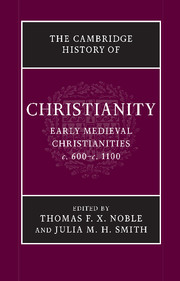Book contents
- Frontmatter
- Introduction: Christendom, c. 600
- Part I Foundations: Peoples, Places, and Traditions
- 1 Late Roman Christianities
- 2 The emergence of Byzantine Orthodoxy, 600–1095
- 3 Beyond empire I: Eastern Christianities from the Persian to the Turkish conquest, 604–1071
- 4 Beyond empire II: Christianities of the Celtic peoples
- 5 Germanic Christianities
- 6 Slav Christianities, 800–1100
- Part II Christianity in Confrontation
- Part III Christianity in the Social and Political Order
- Part IV Christianity as Lived Experience
- Part V Christianity: Books and Ideas
- Conclusion: Christendom, c. 1100
- Bibliographies
- Index
- References
4 - Beyond empire II: Christianities of the Celtic peoples
from Part I - Foundations: Peoples, Places, and Traditions
Published online by Cambridge University Press: 28 March 2010
- Frontmatter
- Introduction: Christendom, c. 600
- Part I Foundations: Peoples, Places, and Traditions
- 1 Late Roman Christianities
- 2 The emergence of Byzantine Orthodoxy, 600–1095
- 3 Beyond empire I: Eastern Christianities from the Persian to the Turkish conquest, 604–1071
- 4 Beyond empire II: Christianities of the Celtic peoples
- 5 Germanic Christianities
- 6 Slav Christianities, 800–1100
- Part II Christianity in Confrontation
- Part III Christianity in the Social and Political Order
- Part IV Christianity as Lived Experience
- Part V Christianity: Books and Ideas
- Conclusion: Christendom, c. 1100
- Bibliographies
- Index
- References
Summary
The inheritance
For this chapter, the Celtic peoples are those which still, in 600 CE, spoke a Celtic language. The continental Celts of antiquity are thus excluded, leaving only the Britons, who inherited their Christianity from Roman Britain, the Irish, who received theirs mainly from the Britons in the fifth and early sixth centuries, and the Picts. By 600 the initial constructive phase of Irish Christianity was over. It was three years since Columba died on Iona; Columbanus had already left Bangor for Burgundy. The great churches of the Irish were nearly all founded in the sixth century. There remained, however, many traces of that earlier period when, because of Irish settlements in Britain and British missionaries in Ireland, the church of the smaller island had been formed in the image of the church of the Britons. The insular scripts, shared by Britons and Irish, are only one especially obvious sign of the connection. The years about 600 were also, however, the time at which the younger Irish Church began to overshadow its British foster-parent. On the one hand, the British Church was suffering territorial loss and impoverishment from the English advance. On the other hand, Columbanus’s letters to the papacy betray a pride in the flourishing Christianity of his homeland.
Not only had the British Church suffered from English advance, it was also threatened by the implications of the Gregorian mission to the English. Moreover, its Breton offshoot had, by 600, been instrumental in driving a wedge between the Christianity of “the Romans” of Gaul, those whom we call Gallo-Romans, and the Christianity of the Britons.
- Type
- Chapter
- Information
- The Cambridge History of Christianity , pp. 86 - 106Publisher: Cambridge University PressPrint publication year: 2008



